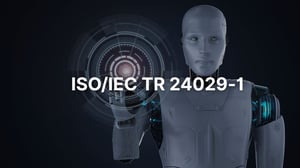
ISO/IEC TR 24029-1:2021
This standard provides a guide to assessing the robustness of an AI system, with a particular focus on neural networks.
As AI systems, especially neural networks, integrate into critical infrastructures, the need for robust and trustworthy AI becomes vital. The ISO/IEC TR 24029-1 report offers a framework to measure and manage neural network robustness, addressing unique challenges and emphasizing continuous assessment to maintain reliability in safety-critical areas.
As artificial intelligence (AI) systems, particularly those based on neural networks, become increasingly embedded in critical infrastructure, business operations, and public services, the need for robust, reliable, and trustworthy AI has never been more urgent. The ISO/IEC TR 24029-1 technical report provides a comprehensive framework for defining, measuring, and managing the robustness of neural networks. This document sets a global benchmark for AI risk management and quality assurance by establishing international standards that ensure these systems' reliability across various sectors.
Understanding Robustness in the Context of Neural Networks
Robustness, as defined by ISO/IEC TR 24029-1, is the ability of a system to maintain its intended level of performance even when exposed to challenges, such as unexpected inputs, adversarial attacks, or environmental changes. While robustness has long been a focus in traditional engineering and information technology, the unique characteristics of neural networks, including their non-linear behavior and data-driven learning processes, introduce complexities that demand specialized assessment methods.

- Unseen, biased, adversarial, or invalid data inputs
- External interference and environmental variability
- Generalization to new domains and operational contexts
- Maintaining reliability under stress
This broader perspective is essential as neural networks are used in safety-critical domains such as autonomous vehicles, healthcare diagnostics, and financial systems, where failures can have significant consequences.
The ISO/IEC TR 24029-1 Robustness Assessment Workflow
The overview of the technical report outlines a structured workflow for assessing neural network robustness, which can be summarized in three key steps:
1. Stating Robustness Goals
The process begins by clearly defining the robustness objectives for the neural network. This involves identifying the specific threats or challenges the AI system must withstand and establishing quantitative metrics to measure success. These goals are tied to real-world needs, aligning with stakeholder requirements and regulatory expectations.
2. Planning Robustness Testing
Once goals are set, the next step is to design a testing strategy that effectively evaluates the neural network's robustness. ISO/IEC TR 24029-1 recommends a combination of statistical, formal, and empirical methods:
- Statistical methods utilize mathematical models and probabilistic testing.
- Formal methods involve mathematical proofs across all possible inputs.
- Empirical methods rely on experimentation, simulation, and expert judgment.
The testing plan specifies environment setup, data collection procedures, and criteria for interpreting results, ensuring rigorous and reproducible assessment.
3. Executing and Interpreting Tests
This step involves conducting tests, analyzing results, and determining whether the neural network meets the robustness criteria. Iterative refinement may be necessary if weaknesses are identified.
Challenges Unique to Neural Network Robustness
Neural networks are highly sensitive to their training data and can exhibit unpredictable behavior with novel inputs, making them vulnerable to adversarial attacks. ISO/IEC TR 24029-1 addresses these robustness issues by advocating for transparency in assessments and encouraging the use of explainable AI techniques. Continuous monitoring and validation throughout the AI system’s lifecycle are critical components of the standard.
Robustness in the Broader AI Governance Landscape
The document aligns with a global movement toward stronger AI governance and risk management. Regulatory frameworks increasingly require organizations to demonstrate the robustness of their AI systems. Adopting standards like ISO/IEC TR 24029-1 supports compliance, builds stakeholder confidence, and provides a competitive advantage in the field of worldwide standardization.
For organizations, platforms like Nemko Digital offer resources for integrating robustness assessment into broader risk management processes. Their partnership with the International Electrotechnical Commission (IEC) and the Technical ISO ensures alignment with industry standards.
Latest Developments in 2025: Robustness in the Age of Generative AI
As of 2025, the adoption of generative AI models has brought new urgency to robustness. High-profile incidents demonstrate the limitations of existing techniques. The AI community is exploring advanced testing methods like automated adversarial example generation and formal verification of neural network properties.
Collaborations on open benchmarks facilitate transparent robustness evaluations. The 6th International Verification of Neural Networks Competition (VNN-COMP'25) exemplifies efforts in advancing formal methods. Initiatives like Math-RoB and ImageNet-D are driving progress in standardized assessments, providing valuable resources for both researchers and practitioners.
Integrating Robustness into the AI Lifecycle
Robustness assessment should be integrated into the entire AI system lifecycle, from initial design to deployment and ongoing monitoring. ISO/IEC TR 24029-1 encourages a holistic approach, leveraging complementary standards such as ISO/IEC 23894 and ISO/IEC 42001 for AI risk and management systems.
The Business Case for Robustness
Beyond compliance, robust AI systems deliver business benefits. They reduce failure risks, enhance user trust, and enable confident deployment of AI in high-stakes applications. Demonstrating compliance with standards like ISO/IEC TR 24029-1 marks quality and a prerequisite for market access, recognized as crucial by consultancies.
Future Implications
ISO/IEC TR 24029-1 marks a significant step in AI robustness standardization, empowering stakeholders to manage risk, ensure compliance, and unlock AI’s potential. Ongoing collaboration between industry, academia, and standards bodies will address emerging challenges and maintain public trust. Utilizing resources like Nemko Digital’s insights and staying abreast of latest research and practices is critical for success in this evolving landscape.




